The AMD Radeon R9 290X Review
by Ryan Smith on October 24, 2013 12:01 AM EST- Posted in
- GPUs
- AMD
- Radeon
- Hawaii
- Radeon 200
Company of Heroes 2
Our second benchmark in our benchmark suite is Relic Games’ Company of Heroes 2, the developer’s World War II Eastern Front themed RTS. For Company of Heroes 2 Relic was kind enough to put together a very strenuous built-in benchmark that was captured from one of the most demanding, snow-bound maps in the game, giving us a great look at CoH2’s performance at its worst. Consequently if a card can do well here then it should have no trouble throughout the rest of the game.
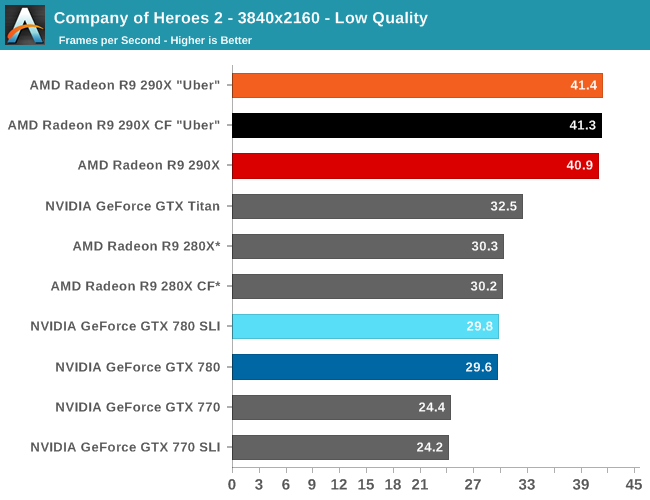
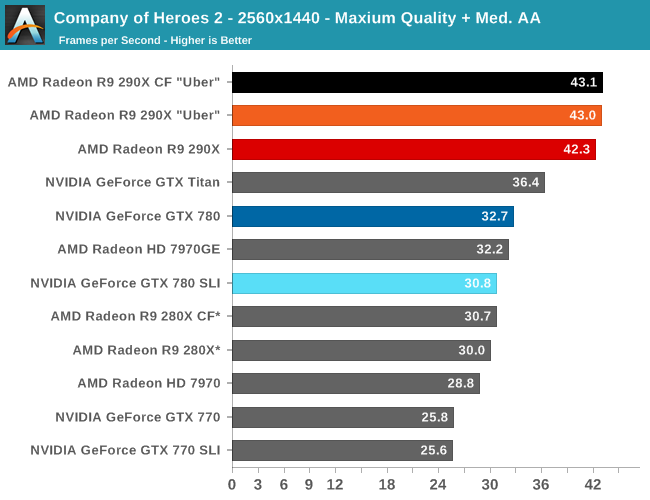
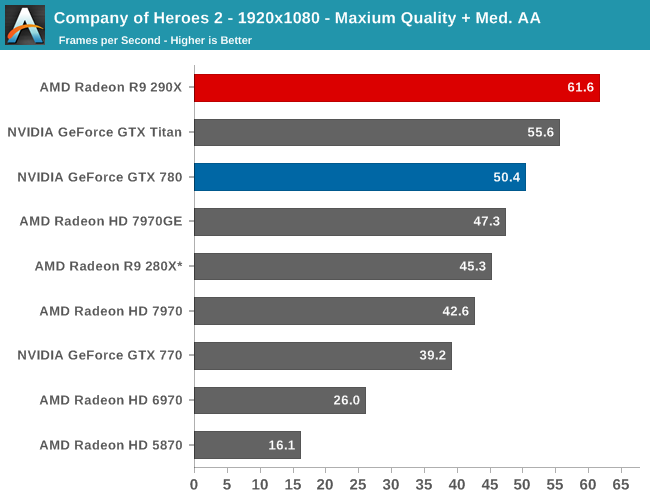
Our first strategy game is also our first game that is flat out AFR incompatible, and as a result the only way to get the best performance out of Company of Heroes 2 is with the fastest single-GPU card available. To that end this is a very clear victory for the 290X, and in fact will be the largest lead for the 290X of all of our benchmarks. At 2560 it’s a full 29% faster than the GTX 780, which all but puts the 290X in a class of its own. This game also shows some of the greatest gains for the 290X over the 280X, with the 290X surpassing its Tahti based predecessor by an equally chart topping 41%. It’s not clear what it is at this time that Company of Heroes 2 loves about 290X in particular, but as far as this game is concerned AMD has put together an architecture that maps well to the game’s needs.
Briefly, because of a lack of AFR compatibility 4K is only barely attainable with any kind of GPU setup. In fact we’re only throwing in the scale-less SLI/CF numbers to showcase that fact. We had to dial down our quality settings to Low on CoH2 in order to get a framerate above 30fps; even though we can be more liberal about playable framerates on strategy games, there still needs to be a cutoff for average framerates around that point. As a result 280X, GTX Titan, and 290X are the only cards to make that cutoff, with 290X being the clear winner. But the loss in quality to make 4K achievable is hardly worth the cost.
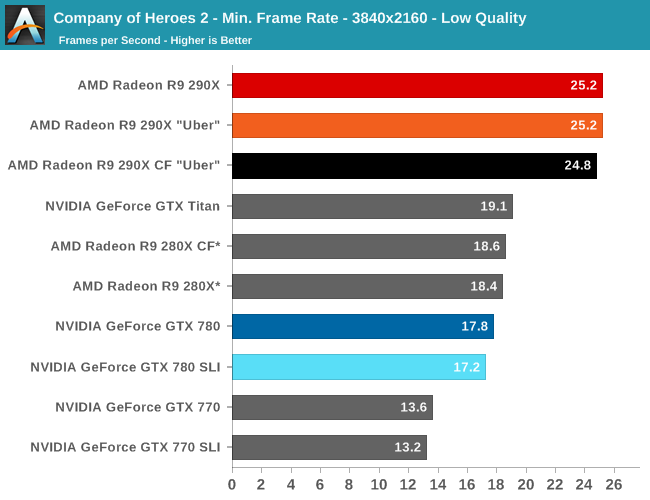
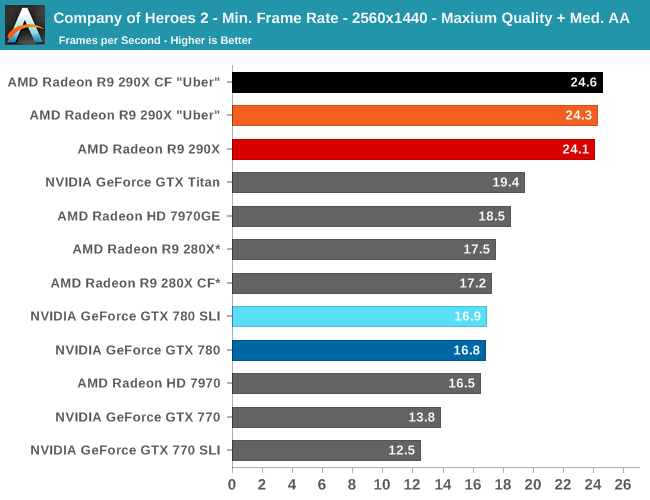

Moving on to minimum framerates, we see that at its most stressful points that nothing, not even 290X, can keep its minimums above 30fps. For a strategy game this is bearable, but we certainly wouldn’t mind more performance. AMD will be pleased though, as their performance advantage over the GTX 780 is only further extended here; a 29% average performance advantage becomes a 43% minimum performance advantage at 2560.
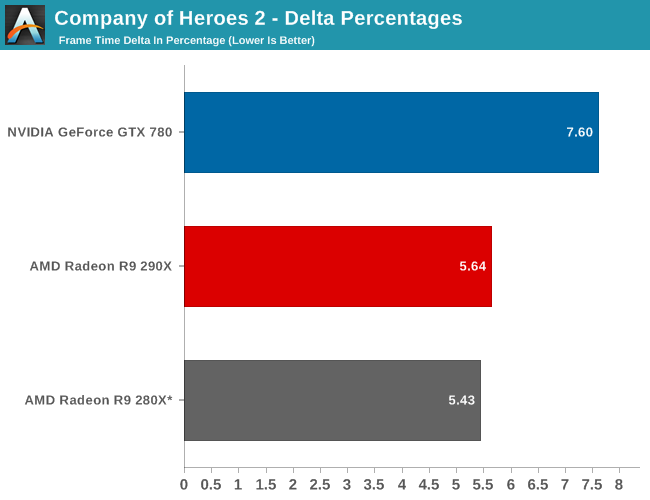
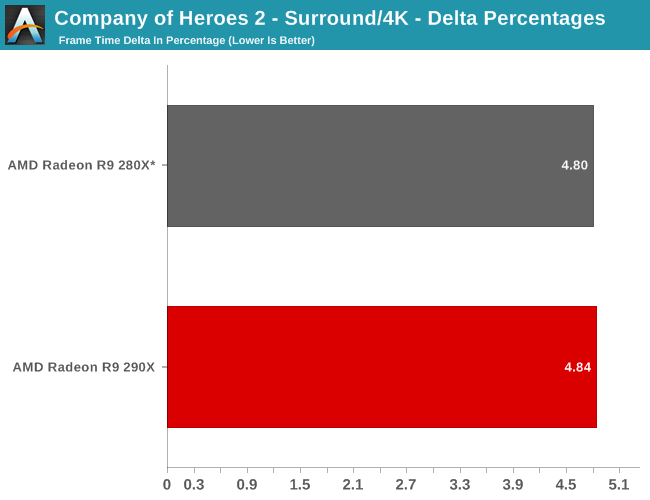
Finally, while we don’t see any performance advantages from AFR on this game we did run our FCAT benchmarks anyhow to quickly capture the delta percentages. Company of Heroes 2 has a higher than average variance even among single cards, which results in deltas being above 5%. The difference between 5% and 7% is not going to be too significant in practice here, but along with AMD’s performance advantage they do have slightly more consistent frame times than the GTX 780. Though in both the case of the 280X and the 290X we’re looking at what are essentially the same deltas, so while the 290X improves on framerates versus the 280X, it doesn’t bring with it any improvements in frame time consistency.










396 Comments
View All Comments
OverclockedCeleron - Thursday, October 24, 2013 - link
That made my day!pattycake0147 - Friday, October 25, 2013 - link
Yes! Comment of the day.TheinsanegamerN - Friday, October 25, 2013 - link
[reply in progress]OverclockedCeleron - Thursday, October 24, 2013 - link
Well done AMD, keep up the good work! Now it's the CPU turn ;).aTaoZ - Thursday, October 24, 2013 - link
Over in the overclocker uk forum, Gibbo is hinting the performance of non-x version in his 290X overclocking review. It is highly possible R9 290 will match GTX780 in performance at an even lower price.steelmilkjug - Friday, October 25, 2013 - link
It's good to see NVidia and AMD jockeying for the high end. Competition always helps keep prices realistic. Everytime I buy GPUs I go through the same mental struggle: Nvidia with better power/temp efficiency (roughly stated I know), AMD with slightly better price/performance ratios, sometimes significantly better. In the end, it always comes down to one thing for me: drivers. NVidia just seems to be more proactive in supporting their products, new drivers seem to come more often, and I feel the affect in games , usually. Less dual card issues, generally and a seemingly broader support of games in general. NVidia is a graphics hardware company specifically. AMD is not. They are a computer hardware company with a graphics department. And it shows. I'm an electrical engineer and I've seen how hard it is to get a job as an NVidia EE. It's a world renowned job, and they only pick the best in the world. I'm not sure AMD is quite as stringent.manicmonday - Friday, October 25, 2013 - link
So you think second tier engineers at AMD created a chip 25% smaller with better performance?SunLord - Friday, October 25, 2013 - link
Did Ryan quit or pass away 1/3 of the way through writing this review other this is pathetic so much for being a top tier review site.piroroadkill - Friday, October 25, 2013 - link
Yep. I gave them a while, some pages have now populated, but there are still too many empty ones. This is pretty poor.These days it seems like Apple gets all the coverage. Well, I couldn't really give a rats ass about massively long Apple articles. After all, Apple just wrap things up (such as GCN, Intel CPUs) into shiny boxes.
I think most of your readership is probably interested in the underlying tech, too.
Da W - Friday, October 25, 2013 - link
Man what do you do for a living? Quit bitching about other people's work, if you're not happy go somewhere else and STFU.